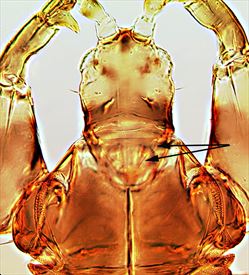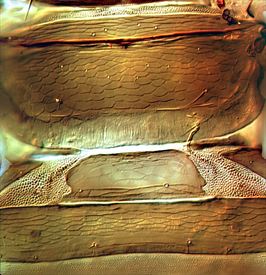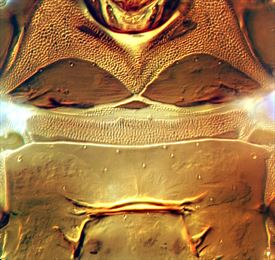Distinguishing features
Female rarely fully winged, usually apterous. Body brown, head pale between eyes; antennal segment I, basal half of II–V, tube, base of tibiae, and parts of femora yellow; major setae brown; fore wings (when present) shaded. Head wider than long, produced in front of eyes; cheeks constricted behind eyes and at base; ocelli well developed in macropterae; ocellar setae long, acute; 2 pairs of acute major postocular setae, median pair well behind eyes, lateral pair almost on cheek; maxillary stylets very short, restricted to mouth cone. Antennal segments VII and VIII closely joined; III and IV each with 2 slender sense cones, on III not extending to mid-point of segment IV. Pronotum sculptured near posterior margin; major setae acute; anteroangular setae shorter; basantra small. Mesopresternum slender, transverse, entire. Metanotum elongate, reticulate medially, with a pair of finely pointed median setae. Fore tarsal tooth small. Fore wing major sub-basal setae acute, S3 longest, S2 lying posterior to S1. Pelta bell-shaped, sculptured; tergites III–VII each with 1 pair of sigmoid wing-retaining setae; tergite IX posteromarginal setae pointed, S1 longer than S2, tube shorter than head, constricted at apex; anal setae short; sternites with about 8 discal setae. Female aptera variable in size; ocelli absent; basantra sometimes absent; mesonotum broadly transverse, with lateral tubercle bearing a stout seta; mesopresternum represented by a thin, broken line; metanotum transverse, partly fused to mesonotum, at least laterally; pelta rectangular, sometimes with margins weakly eroded, bearing 2 small lateral lobes; abdominal segments II–IV with tergites much shorter than sternites; tergites III–VII each with 1 pair of very small, straight wing-retaining setae.
Male similar to female aptera, tergite IX setae S2 scarcely half as long as S1; fore tarsal tooth larger, recurved. Large males with a greatly enlarged fore tarsal tooth and swollen fore femora; head longer than wide, often with a ventral tubercle between eyes; setae on head and pronotum long, slender; pronotum enlarged; tergite IX often with a small, blunt tubercle between posteromarginal setae.
Related species
The genus Sophiothrips comprises 31 species worldwide. Five of these are endemic to Australia, with one of these five also in New Zealand. Three further species constitute the duvali-group in which antennal segment III bears 2 sense cones instead of just a single sense cone. One of these three species is known only from Norfolk Island, but the other two are endemic to New Zealand (Mound & Tree, 2014). S. aleurodisci differs from the related species S. duvali in the form of the pelta, the shorter antennal sense cones, and the smaller tubercle on tergite IX of large males.
Biological data
Found living on dead twigs in association with a coral-spot fungus (Aleurodiscus sp.).
Distribution data
Known only from New Zealand (AK, CL / NN, BR).
Family name
PHLAEOTHRIPIDAE, PHLAEOTHRIPINAE
Species name
Sophiothrips aleurodisci Mound & Walker
Original name and synonyms
Sophiothrips aleurodisci Mound & Walker, 1982: 349
References
Mound LA &Tree DJ (2014) The minute, fungus-feeding species of Sophiothrips (Thysanoptera, Phlaeothripinae) from Australia and New Zealand. Zootaxa 3860 (2): 184–194.
Mound LA & Walker AK (1986) Tubulifera (Insecta: Thysanoptera). Fauna of New Zealand 10: 1–140.



